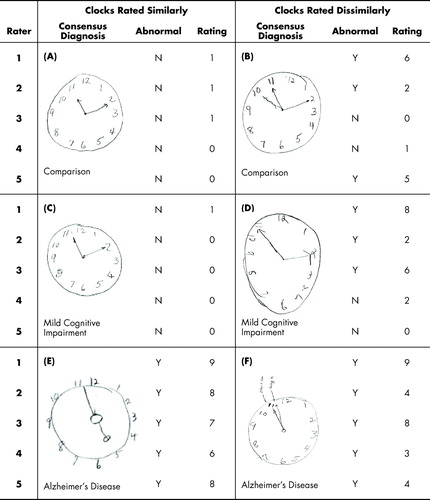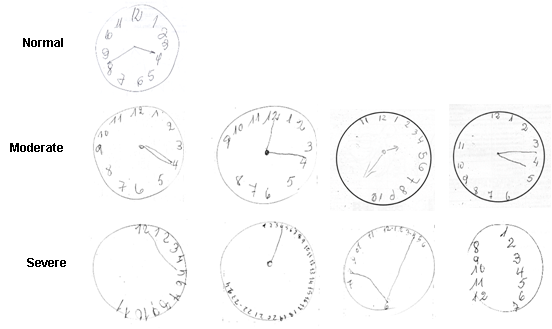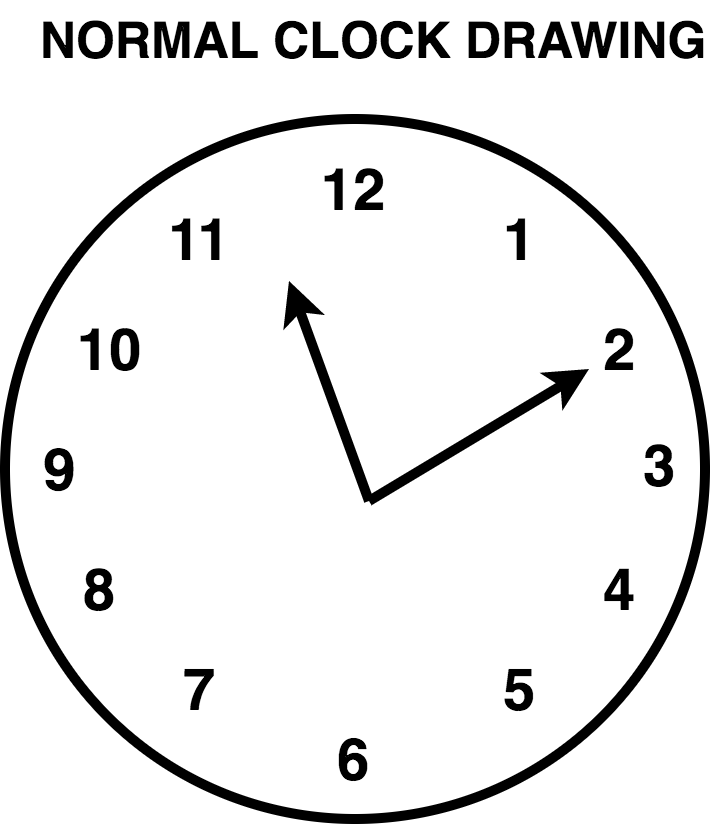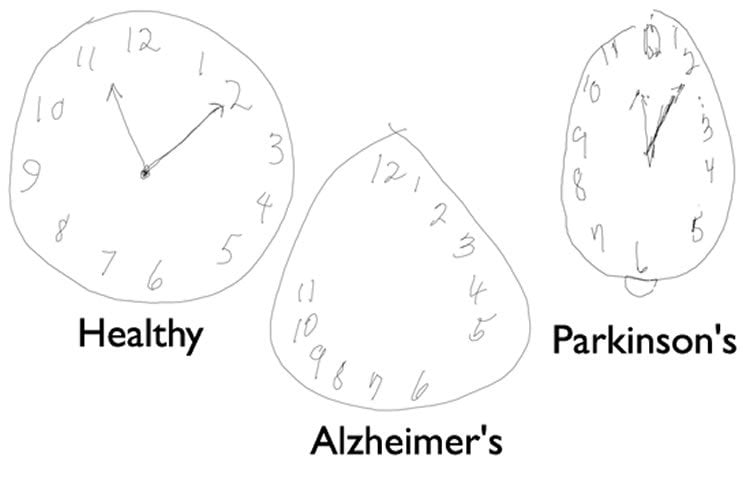Clock Drawing Test Results
The clock drawing test in primary care 2 points for a normal clock or 0 zero points for an abnormal clock drawing.
Bringing the Best for You Clock drawing test results

Hand length is not scored in the Mini-Cog algorithm. clock drawing test CDT has been proposed as a quick screening test for cognitive dysfunction secondary to dementia delirium or a range of neurological and psychiatric illnesses Cucinotta D 2004. According to a clinical neuropsychologist people who have trouble with visuoconstruction skills often struggle with daily tasks such as arithmetic driving and writing Impaired ability to draw a complex shape such as a clock is often called constructional apraxia or CA. It is a reliable screening tool for cognitive dysfunction particularly for dementia.
Usually a medical expert assesses the sketches to discover any deficiencies in the cognitive processes of the patient. Qualitative aspects of the test are also described. A score of 3 represents a cognitive deficit while a score of 1 or 2 is considered normal.
The Clock-Drawing Test CDT is a simple and effective cognitive test used to assess executive function and visual-spatial function. A normal clock must include all numbers 1-12 each only once in the correct order and direction clockwise. Draw a clock by hand on a large piece of paper about 10 cm in diameter.
The model should contain all the numbers on the clock be 3 inches in diameter and located on the CDK can be effectively administered to resistant Draw the face of a clock and put the numbers in the correct positions.
Correlations with the Mini-Mental State Examination and other cognitive tests was high generally greater than r 05 clock-drawing test is a good screening test for dementia and cognitive dysfunction with the possible exception of cases of very early Alzheimers disease findings indicate that the accuracy of the clock drawing test using the Shulman system was the most studied and highly sensitive.
Among published studies the mean sensitivity 85 and specificity 85 of the clock-drawing test are impressive. Assess the clock looking for abnormalities. Kirby M Denihan A Bruce I Coakley D Lawlor BA.
Then draw the hands to indicate 3 time. Clock-drawings from 121 participants 76 individuals with no dementia and later did not develop dementia after a mean 412-month follow-up individuals with no dementia became demented after a mean 423-month follow-up were analyzed using t-test clock-drawing test has been shown to be an acceptable non-threatening assessment20 that is reliable and effective for diagnosis and longitudinal assessment of cognition12 13 14 20 21 22 23 24 25 and correlates with the MMSE score15 26 Like the MMSE the clock-drawing test can be education dependent27 particularly when a predrawn circle is not provided.
Result should be a well-planned and organized clock face. B No semblance of a clock at all c Writes a word or name Shulman et al 1993 Higher scores reflect a greater number of errors and more impairment. Results of the Leipzig Longitudinal Study of the Aged LEILA 75 Volume 23 Issue 10 Lena Ehreke a1 Tobias Luck a1 a2 Melanie Luppa a1 Hans-Helmut König Arno Villringer and Steffi G.
More on how to assess the Clock-Drawing Test results below. If your loved one is distracted or refuses to draw after having agreed to do so you might consider these actions as a fail and seek further assessment from a doctor. In the Sunderland system these were 726 and 8 respectively.
Clock Drawing Test screening utility for mild cognitive impairment according to different scoring systems. There must also be two hands present one pointing to the 11 and one pointing to 2. However it lacks sensitivity for the diagnosis of early or mild dementia.
I would like you to draw a clock put in all the numbers and set the hands for 10 after 11 Following this condition the patients should be instructed to copy as accurately as possible a clock from a model pooled sensitivity and specificity of the clock drawing test using the Shulman system were 82 and 757 respectively. A clock drawing test CDT is a neurological test used for the assessment of cognitive impairment based on sketches of a clock completed by a patient.
 Clock Drawing And Mmse Pentagons In Various Neurological Disorders Table
Clock Drawing And Mmse Pentagons In Various Neurological Disorders Table
 Clock Drawing Test Ratings By Dementia Specialists Interrater Reliability And Diagnostic Accuracy The Journal Of Neuropsychiatry And Clinical Neurosciences
Clock Drawing Test Ratings By Dementia Specialists Interrater Reliability And Diagnostic Accuracy The Journal Of Neuropsychiatry And Clinical Neurosciences
 Scoring Systems Of The Clock Drawing Test O All Of The Scoring Scientific Diagram
Scoring Systems Of The Clock Drawing Test O All Of The Scoring Scientific Diagram
 Clock Drawing Cognitive Test Should Be Done Routinely In Patients With High Blood Pressure
Clock Drawing Cognitive Test Should Be Done Routinely In Patients With High Blood Pressure
 Researchers Assess Usefulness Of Clock Drawing Cognitive Test In Patients With High Blood Pressure Technology Networks
Researchers Assess Usefulness Of Clock Drawing Cognitive Test In Patients With High Blood Pressure Technology Networks
 Examples Of Clock Drawing Test Performance Identify Cognitive Impairment Scientific Diagram
Examples Of Clock Drawing Test Performance Identify Cognitive Impairment Scientific Diagram
 Scoring The Mini Cog C Mini Cog C
Scoring The Mini Cog C Mini Cog C
cq9jr42dq7dt2gtj96fozp89 Wnksuxw7xaxo9fkb9 6uszm C3
 Clock Drawings And Test Scores For Patients Without Dementia And Those Scientific Diagram
Clock Drawings And Test Scores For Patients Without Dementia And Those Scientific Diagram
 Assessment Of Older People 4 Assessing The Psychological Domain Nursing Times
Assessment Of Older People 4 Assessing The Psychological Domain Nursing Times
 Alzheimer S Can Be Diagnosed By Drawing A Clock Interestingasfuck
Alzheimer S Can Be Diagnosed By Drawing A Clock Interestingasfuck
 Clock Drawing Test Cdt Psychdb
Clock Drawing Test Cdt Psychdb
 Detecting Alzheimer S Disease By Drawing A Clock Face With A Digital Pen Neuroscience News
Detecting Alzheimer S Disease By Drawing A Clock Face With A Digital Pen Neuroscience News
 For The Clock Drawing Test The Patient Is Asked To Draw A Clock Put Scientific Diagram
For The Clock Drawing Test The Patient Is Asked To Draw A Clock Put Scientific Diagram
 Clock Drawing Test Cdt Strokengine
Clock Drawing Test Cdt Strokengine
 Clock Drawing Test Geriatric Primary Care
Clock Drawing Test Geriatric Primary Care
 Researchers Assess Usefulness Of Clock Drawing Cognitive Test In Patients With High Blood Pressure Technology Networks
Researchers Assess Usefulness Of Clock Drawing Cognitive Test In Patients With High Blood Pressure Technology Networks
 Telling Time Worksheets Telling Time Worksheets Time Worksheets Clock Worksheets
Telling Time Worksheets Telling Time Worksheets Time Worksheets Clock Worksheets
 Clock Drawings And Test Scores For Patients Without Dementia And Those Scientific Diagram
Clock Drawings And Test Scores For Patients Without Dementia And Those Scientific Diagram





